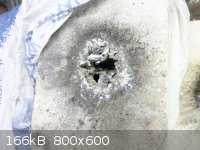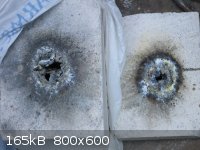metalresearcher
National Hazard
   
Posts: 731
Registered: 7-9-2010
Member Is Offline
Mood: Reactive
|
|
Silicon Thermite
According to this website making Si metal without Sulfur, I tried the lowest ratio 100:72:27 (I made 100:75:30). It reacted violently and really spewed out.
But no Si metal found. Should I moderate it with e.g. CaF2 (available on ebay) ?
<iframe sandbox width="640" height="360" src="//www.youtube.com/embed/BM9WNZB36FA" frameborder="0" allowfullscreen></iframe>
|
|
|
elementcollector1
International Hazard
    
Posts: 2684
Registered: 28-12-2011
Location: The Known Universe
Member Is Offline
Mood: Molten
|
|
I would suggest adding sulfur - it simply seems to work better that way. Sulfur and aluminum provide a very hot reaction, and this is usually enough
to get the temperature up to what you need it to be.
Elements Collected:52/87
Latest Acquired: Cl
Next in Line: Nd
|
|
|
Gargamel
Hazard to Others
  
Posts: 166
Registered: 9-3-2013
Member Is Offline
Mood: No Mood
|
|
Wouldn't the resulting silicon just burn immediately at these temperatures and thus create new dioxide?
|
|
|
Fantasma4500
International Hazard
    
Posts: 1677
Registered: 12-12-2012
Location: Dysrope (aka europe)
Member Is Offline
Mood: dangerously practical
|
|
silicon surely does burn, of you added KNO3 you would likely get partially KNO3 / Al and KNO3 / Silicon
i know with NaOH / Mg you cover up the 'reaction vessel' in order for that the newly formed metal wont combust
i found it to be working decently when doing this with LiOH and Mg powder, and that the lithium metal would totally burn away, i tested this as i saw
no lithium methoxide flame colour when i added the residue to methanol
|
|
|
AndersHoveland
Hazard to Other Members, due to repeated speculation and posting of untested highly dangerous procedures!
    
Posts: 1986
Registered: 2-3-2011
Member Is Offline
Mood: No Mood
|
|
Perhaps Aluminum Silicide was being formed?
Al4Si3
you could try dissolving the slag in dilute hydrochloric acid and seeing if any flame bubbles form, since silane is pyrophoric
[Edited on 1-9-2013 by AndersHoveland]
|
|
|
metalresearcher
National Hazard
   
Posts: 731
Registered: 7-9-2010
Member Is Offline
Mood: Reactive
|
|
BTW I did not mention that in this topic but it was 100 SiO2, 72 Al, 27KClO3.
The SiO2 was not that fine it was so called 'silver sand' from a pet shop for bottoms of bird cages.
I'll try again but close off the reaction vessel with a piece of YTONG to prevent spewing out of the reaction products.
[Edited on 2013-9-1 by metalresearcher]
|
|
|
metalresearcher
National Hazard
   
Posts: 731
Registered: 7-9-2010
Member Is Offline
Mood: Reactive
|
|
Here the test with closed lid. Black stuff appeared which I am going to dissolve in diluted HCl.
<iframe sandbox width="640" height="360" src="//www.youtube.com/embed/-xbE5IJxmo0" frameborder="0" allowfullscreen></iframe>
Dissolving in diluted HCl did not leave any gas bubbles even when heating the colution.
[Edited on 2013-9-1 by metalresearcher]
|
|
|
kafer96
Harmless

Posts: 4
Registered: 31-8-2013
Member Is Offline
Mood: No Mood
|
|
Maybe KClO3 increases the temp. too much and silicon, as somebody already said, burns again to oxide? I think that using sulfur will decrease the
temp. of burning mixture and more silicon will remain. But then you'll have a hard time washing silicon from Al2S3. 
|
|
|
metalresearcher
National Hazard
   
Posts: 731
Registered: 7-9-2010
Member Is Offline
Mood: Reactive
|
|
Dissolving in dilute acid e.g. HCl or H2SO4 ? This will react with Al2S3 and release stink gas H2S.
|
|
|
plante1999
International Hazard
    
Posts: 1936
Registered: 27-12-2010
Member Is Offline
Mood: Mad as a hatter
|
|
Metalresearched, I would higly reccomend you to send a U2U to blogfast about this.
I never asked for this.
|
|
|
kafer96
Harmless

Posts: 4
Registered: 31-8-2013
Member Is Offline
Mood: No Mood
|
|
Yes, I meant liberation of H2S while washing it with dilute acids.
|
|
|
feacetech
Hazard to Others
  
Posts: 163
Registered: 12-2-2007
Member Is Offline
Mood: No Mood
|
|
Hmm i might have to try this with the amorphous silica from our scrubber
its extremly fine and very reactive
its realy quite odd, it has non newtonian propities. Behaves like a fluid when u shake it in a jar.
|
|
|
12AX7
Post Harlot
    
Posts: 4803
Registered: 8-3-2005
Location: oscillating
Member Is Offline
Mood: informative
|
|
FYI, Al4Si3 doesn't exist: rather, the two form a simple two phase eutectic system. Silicon and aluminum are good buddies. 
I'd say you used too much chlorate: reduce the ratio of (Al + KClO3) to (Al + SiO2) until it burns smoothly. Or, if it's a proven ratio, try coarser
particle sizes for a slower reaction.
In another thread, I told blogfast I suspected KClO3 might cause problems -- KCl is gaseous at that temperature, and KClO3 first decomposes to KCl and
O2 before the aluminum burns, so there's plenty of opportunity for gas to push things around. At the ratios he used, it was okay, but too much of
anything so aggressive will of course throw things around. 
Tim
|
|
|
metalresearcher
National Hazard
   
Posts: 731
Registered: 7-9-2010
Member Is Offline
Mood: Reactive
|
|
Anyway I tried the Sulfur method:
9 parts SiO2, 10 parts Al and 12 parts S. It reacted slower and still have to open the reaction vessel (25mm hole drilled in YTONG brick) to collect
the result.
<iframe sandbox width="640" height="360" src="//www.youtube.com/embed/9HHst0t6OYk" frameborder="0" allowfullscreen></iframe>
|
|
|
bfesser
Resident Wikipedian
    
Posts: 2114
Registered: 29-1-2008
Member Is Offline
Mood: No Mood
|
|
You always show the reaction and then the slow motion, but you never show the product once it's cooled. I find this to be repetitive/annoying
(slow-motion) and rather pointless. We all know what a thermite reaction looks like; show us the products. Also, more data is essential. As an
example of what you're doing wrong; you've given poorly defined ratios and "parts." Are you measuring by mass, moles, or volume (the wrong way)?
Inexplicably, you specified the hole size in your brick as 25mm—this is irrelevant.
In short; <em>more science, less k3wlism!</em> Considering the current quality of this thread, it belongs in Beginnings.
I try not to interfere in Energetic Materials, but come on...
|
|
|
metalresearcher
National Hazard
   
Posts: 731
Registered: 7-9-2010
Member Is Offline
Mood: Reactive
|
|
The ratios are always by mass. The amount was about 22g altogether.
Here a photo of the results. Very hard and brittle. Must be mixture of Si and Al2S3.
 
|
|
|
bfesser
Resident Wikipedian
    
Posts: 2114
Registered: 29-1-2008
Member Is Offline
Mood: No Mood
|
|
A bit better. Thanks. What about chemical analyses of the products? Have you performed any?
|
|
|
Marvin
National Hazard
   
Posts: 995
Registered: 13-10-2002
Member Is Offline
Mood: No Mood
|
|
It doesn't reach our normal standards for chemistry but in pyrotechnics parts are always by mass. Anything that produces gas - sulfur, chlorate,
residual water - will tend to turn your reaction into a fountain, destroying any silicon you form. I really don't like the look of these mixtures and
it may not be feasible to use a self sustained reaction with small amounts anyway. I have a book which recommends fine silica and magnesium powder
heated in a hard glass test tube and describes a red glow traveling through the mixture when the reaction starts. If you have magnesium I can search
for the details, one other advantage is that magnesium oxide can be dissolved in dilute hydrochloric acid. If you must use aluminium then starting
with tiny amounts to gauge the violence of the reaction may be the way to go.
|
|
|
aldofad
Hazard to Self
 
Posts: 56
Registered: 30-6-2013
Member Is Offline
Mood: No Mood
|
|
Watch my thermites videos. Formulas are included, results are extremely effective and powerful
http://m.youtube.com/#/watch?v=6WeA1kkA9qg&feature=c4-feed-u
and
http://m.youtube.com/#/watch?feature=c4-feed-u&v=0A3o0Ty9Ha0
Cheers!
[Edited on 7-9-2013 by aldofad]
[Edited on 7-9-2013 by aldofad]
|
|
|
metalresearcher
National Hazard
   
Posts: 731
Registered: 7-9-2010
Member Is Offline
Mood: Reactive
|
|
Here another attempt to obtain Silicon: using SiO2 + Mg powder.
I now also filmed the post processing to show more information.
It resulted in a black powder which did not burn like charcoal powder only got white on some parts which states that it is Silicon as it then would
burn to white SiO2.
But why a powder ? I thought the reaction temperature of Mg + SiO2 is >1400 C so the Si appears in liquid state ??
What are your thoughts ?
<iframe sandbox width="640" height="360" src="//www.youtube.com/embed/cfH_V701EHo" frameborder="0" allowfullscreen></iframe>
|
|
|
12AX7
Post Harlot
    
Posts: 4803
Registered: 8-3-2005
Location: oscillating
Member Is Offline
Mood: informative
|
|
Looks like too small a run to reach the melting point. Maybe try again with 100g say? 
Tim
|
|
|
bfesser
Resident Wikipedian
    
Posts: 2114
Registered: 29-1-2008
Member Is Offline
Mood: No Mood
|
|
Oxides & surface tension come to mind.
|
|
|
MrHomeScientist
International Hazard
    
Posts: 1806
Registered: 24-10-2010
Location: Flerovium
Member Is Offline
Mood: No Mood
|
|
You may also want to treat your sand to remove impurities, so your stoichiometry is more accurate. Reacting some sand with hydrochloric acid will
dissolve any bits of seashells, and a few water washes with remove these and other solubles like salt. Maybe also a seive to separate seaweed, rocks,
or whatever those black bits are.
I've only ever done the reaction with sulfur, and got some decent silicon from it. (see my YouTube channel for a video) I've used
CaF<sub>2</sub> in a few titanium thermites, as a slag fluidizer. That seems to work quite well, and would also serve to 'dilute' your
reaction mix if needed. I got that idea from blogfast, and I also recommend you contact him. He's the resident thermite expert.
|
|
|